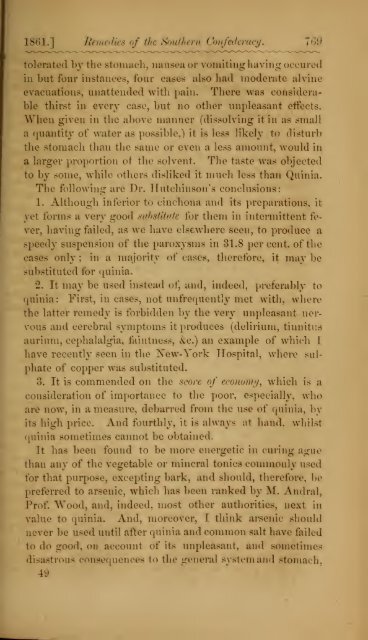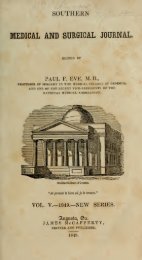Issue 10, pp. 753-832, October 1861, SMSJ
Issue 10, pp. 753-832, October 1861, SMSJ
Issue 10, pp. 753-832, October 1861, SMSJ
You also want an ePaper? Increase the reach of your titles
YUMPU automatically turns print PDFs into web optimized ePapers that Google loves.
<strong>1861</strong>.] Remedies of th Southern Confederacy, 760tolerated by the stomach, nausea or vomiting having occuredin but four instances, four cases also had moderate alvineevacuations, unattended with pain. There was considerablethirst in every cum-, hut no other unpleasant effects.When given in the above manner (dissolving it in as smalla quantity of water as possible,) it is less likely to disturbthe stomach than the same or even a less amount, would ina larger proportion of the solvent The taste was objectedto by some, while others disliked it much less than Quinia.The following are Dr.Hutchinson's conclusions:1. Although interior to cinchona and its preparations, ityet forms a very good substitute for them in intermittent fever,having failed, as we have elsewhere seen, to produce aspeedy suspension of the paroxysms in31.8 percent of the- only: in a majority of cases, therefore, it may hesubstituted for quinia."2. It may be used instead of, and, indeed, preferably toquinia: First, in cases, not unfrequently met with, wherethe latter remedy is forbidden by the very unpleasant nervousand cerebral symptoms it produces(delirium, tinnitusaurium, cephalalgia, faintness, &c.) an example of which 1have recently seen in the Xew-York Hospital, where sulphateof co<strong>pp</strong>er was substituted.3. It is commended on the score of economy, which is aconsideration of importance to the poor, especially, whoare now, in a measure, debarred from the use of quinia, byits high price. And fourthly, it is always at hand, whilstquinia sometimes cannot be obtained.It has been found to be more energetic in curing aguethan any of the vegetable or mineral tonics commonly usedfor that purpose, excepting bark, and should, therefore, bepreferred to arsenic, which has been ranked by If.Andral.Prof. Wood, and, indeed, most other authorities, next invalue to quinia. And, moreover, I think arsenic shouldnever be used until after quinia and common salt have failedto do good, «Mi account of its unpleasant, and sometimesdisastrous consequences to the general system and Btomach,49








